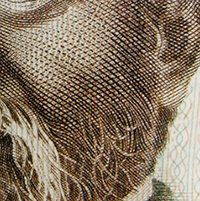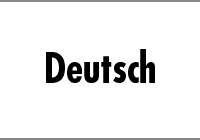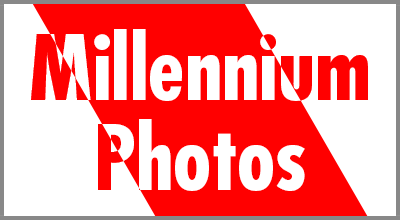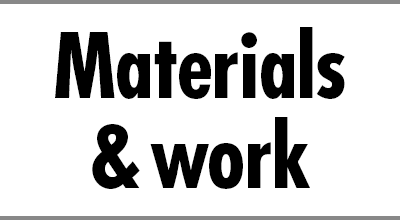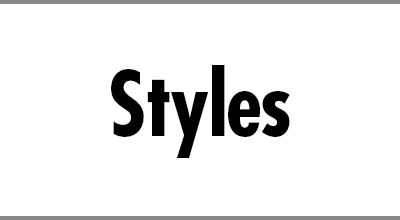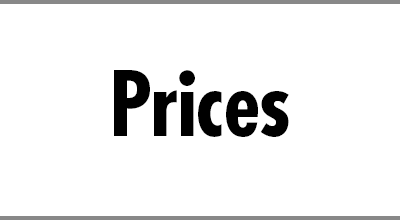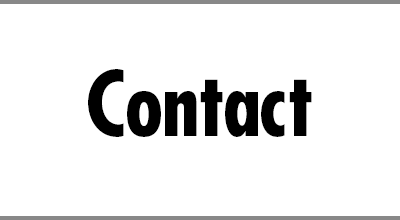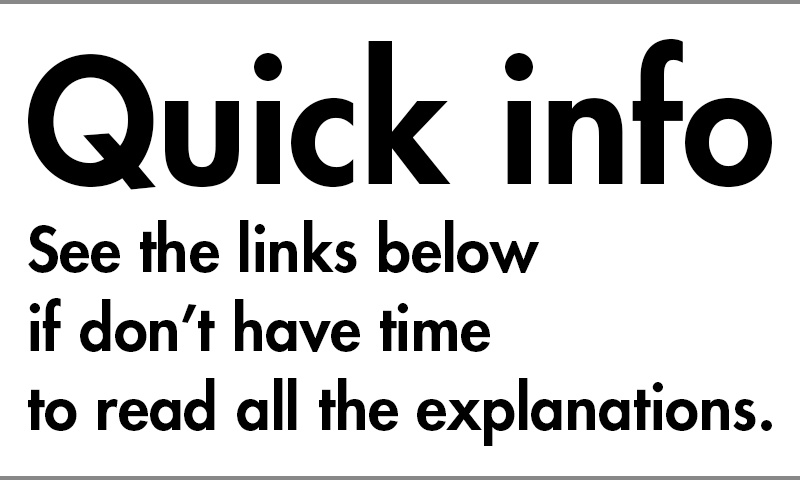Copper etching
Some metallic signboards at historic buildings and tourist sites have photos embedded in them. These photos are completely different from Millennium Photos and Stainless Photos. Starting with explanations on how they are different, we will explain the engraving method unique to Millennium Photos.
There are mainly two types of metallic signboards for outdoor use. The first type involves drawing images on the surface of a metal board with a flat surface. The other involves engraving a metal plate, after which black of other colored pigments are coated into the engraved grooves, and you can feel a large number of small uneven parts when you touch the surface.
In this way, there are two different types of processes; however, they are similar in that both have aggregations of small black dots to express image brightness. When seen from a distance, they look like smooth photographs. It can be said these are similar to printing in newspapers and magazines. Fine parts can be clearly expressed with smaller dots; however, these methods simply replace the paper media of printing materials with metal plates, and do not have any particular novelty and attractiveness in terms of their appearance.
On the other hand, with a Millennium Photo, the brightness of the original images is expressed using the aggregation of fine lines.
Take out a banknote from your wallet. You can see that the portrait is most likely drawn with many lines. Dark parts such as the part under the chin are drawn with a large number of thick lines, and bright parts such as the forehead and cheeks are drawn with a small number of fine lines. This is how image brightness is expressed on banknotes.
Lines used on such objects are not simple parallel lines but meandering flexible curves which run alongside the shape of the face and the contours of clothes. With this method, not only the brightness but also the 3D feel of the depicted person is also expressed at the same time. In order to prevent forgery, banknotes are printed after the portraits on them are drawn and manufactured using this technique, which requires a significant amount of work, instead of by using simple dots. This technique only can be used by skilled professionals; however, the number of professionals with this skill has been decreasing in recent years. It has been said that the current level of technique is lower than it used to be, and some people say that the portraits on older banknotes were better than those on newer ones.
At Millennium Photo, we have refined this advanced technique, and apply it to engraving on metal plates to reproduce three-dimensional photos. By doing this we are performing a task similar to drawing a portrait on a unique banknote issued only to a single customer.
However, it goes without saying that banknotes and Millennium Photos have different processes leading to different finishing due to their differences in printing and engraving.
Moreover, we cannot spend the same amount of time and work on one single Millennium Photo as the government can on printed banknotes. With that said, we always employ a level of craftsmanship in creating our products equivalent to that in creating banknote originals.
In etching, a deep dark color is expressed by intersecting lines, and a three-dimensional feel is also achieved. However, it is difficult to reproduce such line intersections on metal engravings due to reasons related to processing and strength. Therefore, in metal engraving, color tones and a three-dimensional feel are reproduced by engraving many wave-shaped curved grooves which do not intersect one another. This technique has been used over many years in copper etching. It is used in expressing color tones and in achieving a three-dimensional feel, and was unique to copper etching and hand-drawn illustrations. While fine granules and dots are used in reproducing flexible color tones in photographs, it was not possible for them to express a three-dimensional feel as in copper etching.
Millennium Photos were invented when we considered how to reproduce a three-dimensional feel on photographs in the same way as on banknotes and copper etching.
A sense of weight
What is the difference between banknotes, copper etching and Millennium Photos?
Some etched drawings are extremely detailed and so precise that they look like photographs. Such etching works are created with outstanding skill; however, is it true that Millennium Photo can easily and simply create such extremely precise images based on photographs?
We explained above that there are two types of metal etching plates. The first one has an almost flat surface colored using silk-screen printing and laser marking, and the second uses metal plates with clearly uneven surfaces created through engraving. A Millennium Photo, in the same way as the latter type of metal engraving, has a deeply engraved uneven surface. If you touch the surface you can clearly feel the unevenness. Millennium Photos achieve this sense of depth more than with copper etching by combining such uneven surfaces and the reproduction of a three-dimensional feel using lines which are similar to those used in copper etching. Millennium Photos have many different appearances depending on the strength of the light and the angle they are viewed from, and achieve unprecedented visual effects which reflect light in complex ways. Simply speaking, Millennium Photos are similar to original copper plates for printing copper etching works, but have much deeper engraving than on such copper plates and show a completely different world through using line width.
Moreover, different background patterns are available, such as wavy patterns. Even though the wavy pattern background uses wavy lines, the background of the original photograph can be clearly reproduced.
This is a unique feature of Millennium Photos which cannot be fully explained on the website or in print. Please visit our workshop and actually see our products.

